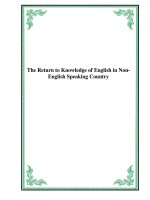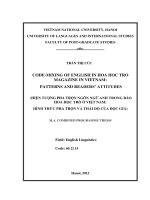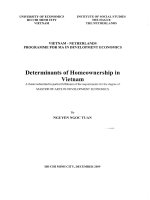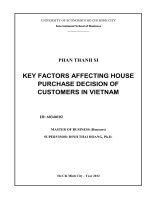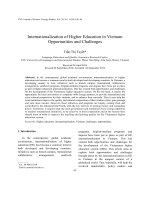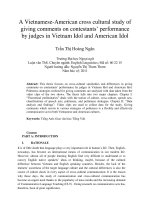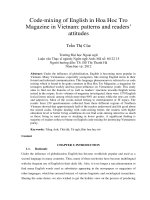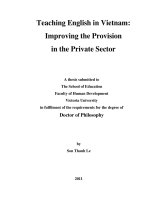Code-mixing of English in Hoa Hoc Tro Magazine in Vietnam patterns and readers’ attitudes
Bạn đang xem bản rút gọn của tài liệu. Xem và tải ngay bản đầy đủ của tài liệu tại đây (258.07 KB, 16 trang )
Code-mixing of English in Hoa Hoc Tro
attitudes
i hc Ngoi ng
ngành: ; 60 22 15
2012
Abstract: Under the influence of globalization, English is becoming more popular in
Vietnam. Many Vietnamese, especially youngsters, like mixing English terms in their
formal and informal communication. This language phenomenon is referred to as code
mixing which is found to be quite common in Hoa Hoc Tro Magazine, a magazine for
teenagers published weekly and has great influence on Vietnamese youth. This study
aims to find out the features
mixed in the corpus. In six volumes of magazine investigated, there were 1379 English
lexical items mixed; among which more than 90% are nouns while the rests are verbs
and adjectives. Most of the words mixed belong to entertainment or IT topics. The
results from 239 questionnaires collected from there different regions of Northern
Vietnam showed that approximately half of the readers understood and felt good about
the mixed codes. Despite dealing with code-mixing better, the readers with higher
education level or better living conditions do not find code-mixing attractive as much
as those living in rural areas or studying in lower grades. A significant finding is
majority of readers refuse to blame on English code-mixing for destroying Vietnamese
purity.
Keywords: ; ; ;
Content
CHAPTER I: INTRODUCTION
1.1. Rationale
Under the influence of globalization, English has become worldwide popular and used as a
second language in many countries. Thus, many of these territories have become multilingual
with the frequent use of English in their daily life. Also, it is no longer a rare phenomenon to
find many English words used as substitutes appearing in the newspapers or magazines of
other languages, which has aroused interest of various linguistic and sociological researchers.
Sharing the same desire, we also wished to get the holistic view on the process of producing
2
gue, Vietnamese, as well
as the reaction of Vietnamese, especially Vietnamese youth, towards the cases.
The reason for me to choose Vietnamese youngsters as the subject of study is that they are
assumed to have the highest frequency of mixing languages in their daily environment.
Obviously, as English have been nationwide taught in all Vietnamese schools for the past ten
years, they could be exposed to English at the early age. As a result, English turns out to be
familiar with them. Additionally, under the boom of entertainment industry and Western
influence, English, more or less, become preferable in media. It was also proved by Leung
(2010) that young people preferred code mixing in advertising.
Since 1970s, quite a number of researches have been done on code-mixing both in spoken and
written languages in China, Hong Kong, Taiwan, and France. In 2003, Ho-Dac Tuc also had a
close view on spoken code-switching of English into Vietnamese community in Australia.
Though valuable results have been found, they still leave the gaps for code-mixing in written
language, i.e magazines and newspapers for Vietnamese youth.
For all of the reasons listed above, this research was carried out to focus on illustrate the
-mixing of English in Hoa Hoc Tro Magazine,
a magazine for Vietnamese youngsters, using eclectic across qualitative and quantitative
methods. The research, once finished, is expected to shed some light on code-mixing patterns
ral, raise sociolinguistics related issues and lay foundation
for further studies.
1.2. Scopes and aims
Although there are various dimensions of code-mixing and magazine languages to be studied,
this combination of qualitative and quantitative study only examines the phenomenon of
code-
work also focuses on the written articles, though code-mixing is more popular in spoken form.
1.3. Research questions
In order to reach the aim o
of code in Hoa Hoc Tro Magazine, the research answered two questions as follows:
1) What are the patterns of code-mixing used in Hoa Hoc Tro Magazine?
2) de-mixing phenomenon in Hoa Hoc Tro
Magazine?
3
CHAPTER II: LITERATURE REVIEW
A-THEORETICAL BACKGROUND
2.1. Code mixing
2.1.1. Code
system of computer programming instructions in computing, or considered as a set of moral
principles or rules in laws or even systems of symbols in telephoning. As this is a
symbols that represent a message or re
Advanced Learners, 8
th
defined as
complex as the entire
2.1.2. Code mixing and code switching
In brief, code switching refers to both inter-sentential and intra-sentential code-alternation
occurring when a bilingual speaker uses more than one language in a single utterance above
the clause level to appropriately convey his/her intents, thus code switching relates to
participants and discourse. Code mixing, whereas, refers to mixing the various language units
below clause level within a sentence, which results no discourse meaning occurring sentence
internally.
2.1.3. Code-mixing and borrowing
Poplack and Sankoff (1984) (see Tuc (2003:9)) discussed the relationship between code-
mixing and borrowing as follows:
Code mixing
Borrowing
Frequent use
-
+
Synonym displacement
-
+
Integration:
Phonological
+/-
+/+
Morphological
-
-
Syntactic
-
+
Acceptability by native speakers
-
+
Table 1: Distinction between code-mixing and borrowing
2.2. Linguistics constraints on code- mixing
Sociolinguists have been interested in not only the functions, meanings and patterns of code
mixing but also the points at which code-mixing occurs in the sentence. In other words, what
are the constraints on code-mixing?
2.2.1. Particular grammatical constraints
4
In 1970s, a large number of researches were carried out to study specific constraints on code
mixing (Gumperz and Hernandez- Chavz 1975; Timm 1975; Lipski 1978; Plaff 1979). Most
of these studies looked at a specific case of code-mixing and impose specific constraints
rather than formulating universal constraints.
Therefore, it has been recognized that the specific constraints are applicable with these
language pairs code mixing but fail to explain the phenomenon among other diverse pairs.
This impair proved the necessity and the extent stimulation of a general theoretical constraints
in later studies on code-mixing.
2.2.2. Universal constraints on code- mixing
In brief, there are there prominent theories on universal constraints on code-mixing.
Equivalence and Free Morphemes Constraints limit the scope of code-mixing in the
equivalence of word order and words category. In other words, code-mixing cannot happen if
the two languages do not have the same structures or a free morpheme can be switched with a
bound one. In Government Constraint, code-mixing will not happen between certain types of
word categories or within prepositional phrase in a clause. Matrix Language Model illustrates
a frame in which system morphemes are embedded into the matrix language. All these
theories, either reach agreement or attacks from research community, carry unconvincing
counter-evidence to attack themselves. While the two former constraints could not be applied
to all specific language pairs, the later one failed to define and distinguish the notion of
system morphemes. Thus, it is reasonable to admit that adequate formulation of constraints on
code-mixing are not yet possible. This study is not meant to support any specific constraint of
code-mixing but rather take these constraints into consideration when dealing with English
and Vietnamese in contact in a given corpus.
2.2.3. Extra-linguistic factors related to code-mixing
Myers- Scotton (1993a) made an attempt to provide a general theoretical explanation of the
sociolinguistic and pragmatic aspects of code- -
mixing is considered as a socially functio
intention. In a given social context, if there are some conventionalized of code choice and
code use, which are expected the majority of speakers, this is called code mixing as unmarked
choice. Whereas, if the speaker uses the unexpected code to negotiate or achieve a strategic
effect in conversation, it is called marked code.
The theory of Markedness model as well as the role of extra-linguistic factors are valuable to
the researcher when she analyzes the patterns of code-mixing in the corpus in later parts. In
this study, the use of English in magazine is regarded as a marked choice because he
5
normative medium (i.e., the unmarked choice) of written communication in Vietnam is
Vietnamese. Hence, this study wil-than-
to English in the Magazine.
2.3. Patterns of code mixing
In order for an easy approach, the researcher took the methods of categorizing codes mixed in
terms of their parts of speech such as Nouns, Verbs, Adjectives, Adverbs and others. This
classification was already done in the empirical studies carried out by different researchers
before. A clear justification of these empirical studies will be illustrated in the following part.
B - EMPIRICAL STUDIES
As taken code mixing is a sub-kind of code switching, the current study adopts the analyzing
classified into parts of speech. The findings of the study would be compared
when relevant. Nevertheless, as the focus of this study is intra-sentential code mixing, all the
cases of English switched above clause level will not be counted. Also, as the given corpus is
a magazine written in spoken language, the method of data collection will be of difference.
No interview will be recorded but will be observed through publications of mentioned
Magazine.
Chen (2006) investigated code-mixing of English in magazine advertisement in Taiwan. Kia
(2011) and his Malaysian colleagues identified the features of English lexical items code-
mixed into Chinese entertainment news.
To be brief
different context with different corpus. At the same time, unlike the focus of the studies on
advertisement in different magazines, it is to focus on a variety of columns but only in one
magazine.
6
CHAPTER III: METHODOLOGY
3.1. Data Corpus
3.1.1. Hoa Hoc Tro Magazine
Hoa Hoc Tro is a magazine published weekly under the verification and censorship of
students of secondary schools, high schools and colleges. As it is written for the youngsters,
the magazine is also believed to
The first volume of Hoa Hoc Tro Magazine was published on October 15
th
, 1991. Up to now,
Hoa Hoc Tro is one of the most successful and best-selling magazines in Vietnam.
3.2. Corpus observation
The volumes are chosen randomly through lot drawing carried out by the researcher to find
out 6 among 60 volumes collected.
Before analyzing, all the cases of code mixing are highlighted and recorded before
categorizing into the patterns of code mixing basing on their parts of speech such as nouns,
verbs, adjectives, adverbs, interjections and others.
Also the frequency of patterns is calculated to see which phenomena are the most common in
the magazine.
3.3. Questionnaires delivery
3.3.1. Sampling
Totally 450 respondents, with 150 from Thai Binh, Son La and Hanoi, were handed the
questionnaires respectively.As the informants are mostly secondary and high school students,
their ages range from 12 to 19. Their first language is Vietnamese, and all of them have
learned English at school.
3.3.2. Questionnaires
The questionnaires comprise 13 questions structured in four main parts.
The first part, also the first question (Q1) asks about the frequency of respondents to read
Hoa Hoc Tro Magazine.
The second part includes two questions exploring if readers can understand English code-
mixing words in the four extracts. Likert scale was used and respondents might select from
Strongly Disagree to Strongly Agree.
7
The third part -mixing of English in
Hoa Hoc Tro Magazine. Likert scale was also implemented in these questions so that
informants selected from Strongly agree to Strongly Disagree.
The last part consists of the questions about personal information of respondents such as age,
place of living, their school and their contact information (if they are willing).
3.4. Data analysis
Research question 1: All the phenomena of English code-mixing were highlighted and
recorded. The codes were categorized according to parts of speech, so that all the code-mixed
words or phrases would be put into these groups of parts of speech to see: (1) Among all the
intra-sentential code-mixed words, what functions most of them have. (2) Which words or
phrases and seem to happen the most often, (3)In which column the frequency of code-mixing
is the highest.
Research question 2:
In part 1: As stated earlier, only answers from those who sometimes, usually and often read
would be taken as valid responses. All the questionnaires will be counted and classified into
valid and invalid groups.
In part 2: In both Questions 1 and 2, Agree and Strongly Agree answers would be counted to
see the percentage of people who (1) understood each extracts of magazine given and (2)
found it comfortable to read the extracts with code-mixing.
Questions in part 3 were similarly analyzed to part 2.
8
CHAPTER IV: PATTERNS OF CODE-MIXING FINDINGS AND DISCUSSION
4.1. Findings of the quantification of mixed word class
From the six volumes of Hoa Hoc Tro Magazine synthesized, 1379 code-mixing of English
phenomena were found into Vietnamese sentences. Among these 1379 intra-sentential code-
mixing words, the most commonly used parts of speech in the sentences are 1261 nouns,
followed by 69 verbs, 53 adjectives and only one interjection. In other words, more than 90%
of the lexical items code-mixed in Hoa Hoc Tro magazine are nouns. Nevertheless, English
pronouns, adverbs, conjunctions, prepositions and interjections are not mixed in Vietnamese
Hoa Hoc Tro Magazine.
4.2. Distribution of mixed words in the corpus
mostly the stories translated from English, there is not even an English word mixed. More or
less mixed words catering are found in other columns. However, the ones with the highest
2 (
(Teen
manual), (Fan club News ), 360
(360 ),
CINELAND,
(Will loves these) and the news about music and film stars
at the back of the magazine.
4.3. Overview description and discussion of mixed word classes
4.3. 1. Nouns
9
-mixed the most in Hoa Hoc Tro magazine. This can be reasoned by
the age of the target readers who are mostly from 11 to 19 years old. Besides, As suggested by
Tuc (2003), Vietnamese do not contain any notion of number or amount. Vietnamese noun is
transnumeral, or in other words, has no marking between singular and plural. Therefore, the
nouns maintain invariable as non-count nouns in English no matter what their number is even
though they followed such numbers as
4.3.2. Verbs
English verbs occupies 5% of total 1329 mixed words. Most of the mixed verbs are in the
-person-singular, past or past participle
forms. Vietnamese verbs are distinguished with English ones by several features. The most
typical one of Vietnamese verbs is that they themselves do not demonstrate a clear notion of
passive verbs. Unlike English verbs, Vietnamese ones are also neutral to tense or grammatical
functions.
4.3.3. Adjectives
The mixed adjectives comprised 3,55% of the total mixed words with 53 words. The most
--
Besides, there are less popular adjecti -
and Vietnamese ones is their position when co-occurrence with nouns. In English, adjectives
are modifiers preceding nouns while the order in Vietnamese is noun + adjective, but mixed
English adjectives in the corpus are in the (i) attribute position, or following nouns, (ii)
predicative position. Many English nouns change their original nominal function to be viewed
as adjectives finally.
4.4.4. Vocabulary combined between English and Vietnamese
In the corpus, there was appearance of the English words change themselves to be similar to
Vietnamese.
Eg 24:
-
10
As Vietnamese is a mono-syllabic language in which all the syllables are meaningful, the
. Some authors also add suffix into Vietnamese words to create new lexical
items. In Eg (28),
Even though the total number of these newly invented words is not large (seven cases), it can
still be inferred that youngsters are very creative in using and combining the two languages.
using languages of the youth, who are always active and desire for movement and innovation.
CHAPTER V: READERS’ ATTITUDES TO CODE-MIXING FINDINGS AND
DISCUSSION
5.1. Part 1 of the questionnaires
There were only 239 valid questionnaires in which all readers respond
5.2. Part 2 of the Questionnaires
Four extracts numbered Extract No.1, Extract No.2, Extract.3 and Extract.4 from four
columns of Hoa Hoc Tro Maga
understanding and comfort while reading code-mixed words. With only around 50% say yes,
tt is apparent that not all of these articles are really understood and favored.
11
5.3. Part 3 of the questionnaires
Unlike part 2 which asks for direct opinions on detailed extracts quoted from specific columns
code-mixing used in Hoa Hoc Tro Magazine.
The results of part 3 of the questionnaires indicates that despite the appearance of code mixing
in the corpus, only nearly half of the respondents could understand the articles, approximately
40% felt comfortable to read or preferred code-mixed articles. These articles also attracted
less than 50% of the readers asked. Nevertheless, when reporting about the negative sides of
these code mixing articles, only almost one fifth of the respondents had difficulties in reading
those articles or accused English code-mixing of contaminating Vietnamese purity.
5.4. Part 4 of the questionnaires
It was supposed that city readers would have better understanding, feel more comfortable,
express more preference, pay more attention, encounter less difficulty and have friendly
attitude towards code-mixing than the two others. Those from the mountainous Son La were
expected to be of the other extreme to Hanoi respondents. As Hanoi capital is a big city with
variety of political, cultural and social activities, respondents from Hanoi have more chances
to be exposed to cultural and entertainment cosmopolitan events. They also have acquired
English earlier in their life through studying at schools or language centers, even in their
families, so their English language background and ability is considerable. Also, mass media
such as TV, Internet, billboards, even posters advertising things on the streets with English
mixed have been common with their life. English is even mixed in their daily conversation to
their friends without awareness. All in all, English has been a familiar phenomenon in their
life as something defaulted. It reflects the familiarity with English words (Leung, 2010).
Therefore, when encountering English phrases mixed in the corpus, they showed themselves
as those who had the most mastering who could understand and be open to English. However,
it was just taken as a normal language event happening, English did not attract much of their
attention and preference.
Regarding educational levels, the respondents were categorized into two groups: (1)
Secondary school and (2) high school. It was found that respondents with higher educational
level could understand better and felt more comfortable with code-mixing. In Q3, only
36,09% of secondary school respondents could understand code-mixing while 52,29 percent
12
of high school ones could do that. Likewise, in Q4, only nearly 30% secondary school
respondents felt comfortable while almost half of high school readers had the same feeling
when reading code-mixing articles. In spite of that, younger readers are more attracted by
articles with code-mixing. In Q6, the percentage of secondary school readers paid attention to
code-mixing is twice as much as that of high school readers. Though both types of
respondents did not have much difficulty in reading code-mixed articles, older readers were
still more tolerant to code-mixing. Only less than 20% high school readers considered code-
mixing as destroying Vietnamese. This reflects that readers with higher education level have
more positive attitudes towards code mixing articles in the corpus.
CHAPTER VI: CONCLUSION
6.1. Summary
With the expectation of finding out the patterns of code mixing (intra-sentential) used in Hoa
Hoc Tro Magazine as well as the reactions of readers towards this phenomenon, the
Equivalence Contraints, Myers-Scottons (1993a) Markedness Model and empirical studies
conducted by Chen (2006), Leung (2010), Kia (2011) on code-mixing in advertisements and
entertainment news in Malaysia, Hong Kong and Taiwan.
Six volumes of Hoa Hoc Tro Magazine were chosen to find out the cases of code-mixing
before categorizing them along parts of speech and the columns in which the frequency was
13
the highest. 239 va
specific extracts as well as code-mixing found in the corpus in general. Places of residents
(including the rural, mountainous and urban areas) and level of education were taken into
consideration in the third part of the questionnaires.
The results showed that there were 1379 English words mixed into six volumes, or an average
of about 200 English words in each volume. Most of the English words mixed are nouns
(91,44%), the rest are verbs (5%) and adjectives (3,56%). Code-mixing is quite popular in the
columns about entertainment, i.e. music or movie; internet and express news. As for the
attitude of readers towards code-mixing in the four extracts, only half of the readers could
understand them or feel comfortable with the English words embedded. This synchronized
with the opinion on code mixing in Hoa Hoc Tro magazine in general in the later parts of the
questionnaires. Nearly 50% of the people asked favored code-mixing or found code-mixing
as a factor to catch their attention. Almost two thirds of the informants disagreed with the
assumed idea that code-mixing destroyed Vietnamese purity.
It was also found that the readers living in the city could understand and feel more
comfortable with code mixing. They also did not find it difficult in reading the code-mixed
articles, therefore they opposed the idea that code-mixing could contaminate Vietnamese.
However, they did not show as much preference and attention to articles with code-mixing as
the respondents from the rural and mountainous areas. The reaction of the older informants
who study at high school was of a similar case with that of those from the cities above. In
other words, the readers at secondary, despite their less understanding and comfort towards
code-mixing, still have higher preference and attention paid to code-mixed articles.
Obviously, there is a high co-relationship between capability of using English and
understanding and accepting code-mixing. The higher their education level is, the more
respondents can understand the code-mixed words. In addition, if the readers are put in the
cosmopolitan or cultural environment, or more exposed to multilingual context, their opinion
on code-mixing is more opened.
6.2. Implications
Though code-mixing is not prevented or rejected by most of the respondents, it has not been
understood by the almost half of them. Many still found English mixed words hard to
understand. It is suggested Hoa Hoc Tro editors as well as writers need to take this into
14
consideration for better service to readers who have not had chances to expose to English
either because of their English level or places of residence. Writers should be more aware of
the difficulty level and the popularity of the words embedded and determine whether code-
properly.
6.3. Limitations
On the basis of previous researches on code-switching and code-mixing of English in other
languages, this study only focuses on a particular magazine for certain readers. Therefore, this
study was not attempted to uncover all the specific or general features of English code mixing
in Vietnamese in general but just to contribute a better understanding of specific code mixing
used in Hoa Hoc Tro Magazine as a result of the influence from the West. The respondents, in
spite of being taken from different places in the North of Vietnam
In order to develop this study, the following section will suggests some areas for further
researches.
6.4. Suggestions for further study
This study only concentrates on written code-mixing in a magazine for teenagers.
Consequently, we recommend that the further researches could be extended into two trends.
One trend is the investigation of English code-mixing in other written magazines and
entertainment news for youngsters to get the whole picture of mixing codes into written press.
The other turns the study on spoken languages news or press for the youth such as radio or
TV. Certainly, there are distinctive differences between the spoken and written style, the
results of these studies will create a panorama of using English mixed in mass media in
general.
References
1. Appel, R and Muysken, P. (1987) Language Contact and Bilingualism, London:
Edward Arnold.
2. Ayeomoni, M.O. (2006) Code-switching and code-mixing: style of language use in
childhood in Yoruba speech communityNordic Journal of African Studies, 15(1),
pp.90-99.
3. Bentahila, A and E.E. Davies bic-French code-
Lingua, 59:301-330.
15
4. Berk-Linguistic Constraints on Intra-Sentential Code-Switching:
A Study of Spanish/Hebrew Bilingualism, Language in Society 15:313-348.
5. Bhatia, T. K., & Ritchie, W. C. (2004) Social and Psychological Factors in Language
Mixing. In W. C. Ritchie and T. K. Bhatia (eds.), Handbook of Bilingualism (pp.336-
352), Blackwell Publishing.
6. Clyne, M. G. (1991a) Community Languages: The Australia Experience, Cambridge
University Press.
7. Chen, C.W. (
World Englishes, Vol.25, No.3/4, pp.467-478.
8. -Papers for the
workshops on constraints, Conditions and Models, Strasbourg: European Science
Foundation Network on Code-switching and Language Contact, Vol.2, 17-46.
9. Gumperz, J.J. and Hernandez-
Ellenguaje de los Chicanos, Arlington, VA: Centre for Applied
Linguistics, 154-64.
10. Gibbons, J. (1987) Code-Mixing and Code-Choice: A Hong Kong Case Study, Bath:
Multilingual Matters.
11. Holmes, J. (1992) An introduction to sociolinguistic, London. Longman.
12. -Mixing of English in
International Journal
of English Linguistics Vol. 1, No. 1; March 2011 , 3-14.
13. Leung, C -Mixing in Print Advertisement and its Cultural
European Journal of Social Sciences Volume 12,
Number 3 (2010) , 417-429.
14. -English code-switching research in Hong Kong: a Y2K
World English, Bol 19, No 3 , 305-322.
15. -switching and the problem o
M. Paradis (ed). Aspects of Bilingualism, Columbia: Hornbeam Oress, 250-63.
16. Liu, P. (2008) Code-switching and Code-mixing, GRIN Verlag.
17. Muysken, P. (2000) Bilingual speech: A typology of code-mixing. Cambridge:
Cambridge University Press.
16
18. Myers-Scotton, C. (1993a) Duelling Languages: Grammatical Structures in
Codeswitching, Oxford: Clarendon Press; New York: Oxford University Press.
19. Myers-Scotton, C. (1993b) Social Motivations for Code-switching, Oxford: Clarendon
Press; New York: Oxford University Press.
20. Nguyen, Hong Con (2003) , Vol
02. Retrieved on September 30
th
,2012 from:
21. -sentential code-switching and
borrowing in Spanish- Language 55, 291-318.
22. Poplack, S. (1979/1980)
espanol: toward a typology of code-switching In L. Wei (ed.), The Bilingualism
Reader, New York: Routledge.
23. Poplack, S. (2001) Code-switching (Linguistic). In N. Smelser & P. Baltes,
eds. International Encyclopedia of the Social and Behavioral Sciences. Elsevier
Science, 2062-2065.
24.
Linguistics 22, 99-136.
25. -
K. J. Mattheier (eds) Sociolinguistics: An introduction Handbook of Language and
Society, Berlin: Walter de Gruyter.
26. h-English code switching: el porque y how-not-
Romance Philology, 28, 473-82.
27. Tuc, H D. (2003) Vietnamese-English Bilingualism: Patterns of Code-switching,
London: RoutledgeCurzon.
